Comparative Study of KNN, J48, and Naive Bayes in Weka Environment
VerifiedAdded on 2023/06/07
|19
|2887
|140
Report
AI Summary
This report presents a comparative analysis of three classification algorithms: K-Nearest Neighbor (KNN), J48 (Decision Tree), and Naive Bayes, using the Weka data mining tool. The study utilizes the Vote.ARFF dataset and evaluates the performance of each algorithm based on metrics such as accuracy, precision, recall, and the confusion matrix. The report details the implementation of each classifier within the Weka environment, including the use of 10-fold cross-validation and the handling of missing values. The results section provides a comprehensive breakdown of each algorithm's performance, including correctly and incorrectly classified instances, precision for different classes, and cost analysis curves. The report concludes with a comparison of the algorithms, identifying J48 (Decision Tree) as the best-performing classifier for the given dataset and discussing the strengths and weaknesses of each approach, providing valuable insights for future research and application in data mining. The report highlights the importance of algorithm selection based on the specific dataset and application requirements.

16
Comparative Exploration of KNN, J48 and
Lazy IBK Classifiers in Weka
Comparative Exploration of KNN, J48 and
Lazy IBK Classifiers in Weka
Paraphrase This Document
Need a fresh take? Get an instant paraphrase of this document with our AI Paraphraser
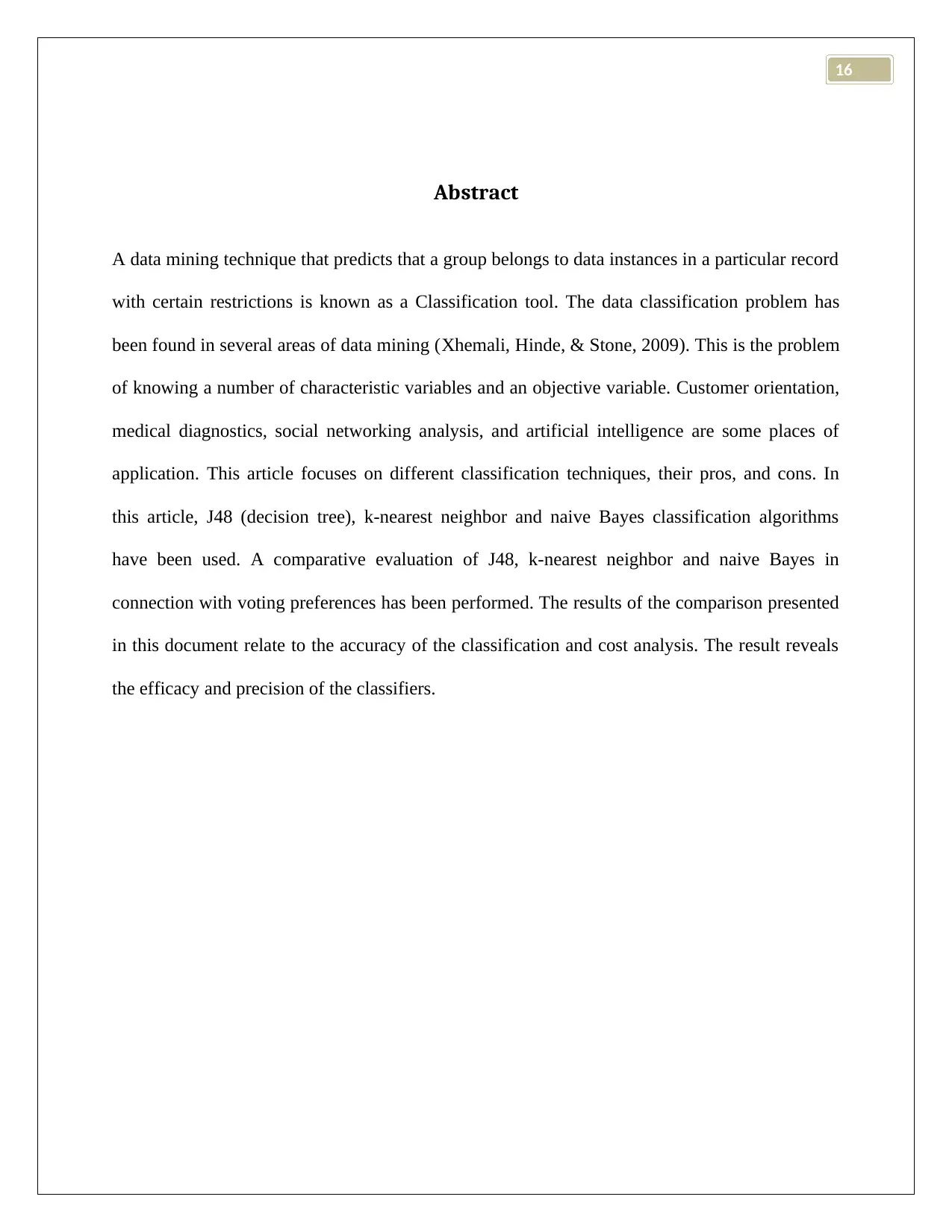
16
Abstract
A data mining technique that predicts that a group belongs to data instances in a particular record
with certain restrictions is known as a Classification tool. The data classification problem has
been found in several areas of data mining (Xhemali, Hinde, & Stone, 2009). This is the problem
of knowing a number of characteristic variables and an objective variable. Customer orientation,
medical diagnostics, social networking analysis, and artificial intelligence are some places of
application. This article focuses on different classification techniques, their pros, and cons. In
this article, J48 (decision tree), k-nearest neighbor and naive Bayes classification algorithms
have been used. A comparative evaluation of J48, k-nearest neighbor and naive Bayes in
connection with voting preferences has been performed. The results of the comparison presented
in this document relate to the accuracy of the classification and cost analysis. The result reveals
the efficacy and precision of the classifiers.
Abstract
A data mining technique that predicts that a group belongs to data instances in a particular record
with certain restrictions is known as a Classification tool. The data classification problem has
been found in several areas of data mining (Xhemali, Hinde, & Stone, 2009). This is the problem
of knowing a number of characteristic variables and an objective variable. Customer orientation,
medical diagnostics, social networking analysis, and artificial intelligence are some places of
application. This article focuses on different classification techniques, their pros, and cons. In
this article, J48 (decision tree), k-nearest neighbor and naive Bayes classification algorithms
have been used. A comparative evaluation of J48, k-nearest neighbor and naive Bayes in
connection with voting preferences has been performed. The results of the comparison presented
in this document relate to the accuracy of the classification and cost analysis. The result reveals
the efficacy and precision of the classifiers.
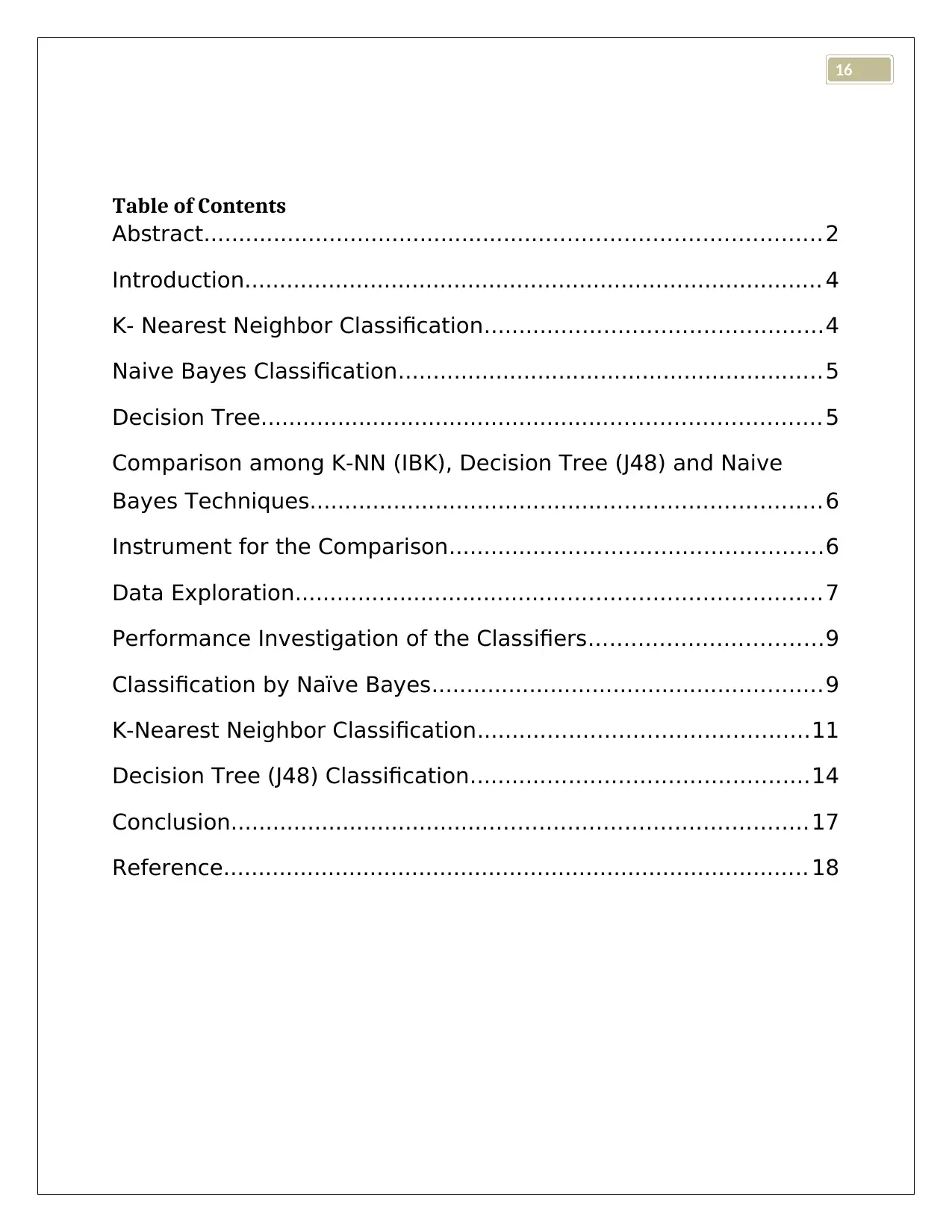
16
Table of Contents
Abstract........................................................................................2
Introduction................................................................................... 4
K- Nearest Neighbor Classification................................................4
Naive Bayes Classification.............................................................5
Decision Tree................................................................................5
Comparison among K-NN (IBK), Decision Tree (J48) and Naive
Bayes Techniques.........................................................................6
Instrument for the Comparison.....................................................6
Data Exploration...........................................................................7
Performance Investigation of the Classifiers.................................9
Classification by Naïve Bayes........................................................9
K-Nearest Neighbor Classification...............................................11
Decision Tree (J48) Classification................................................14
Conclusion..................................................................................17
Reference.................................................................................... 18
Table of Contents
Abstract........................................................................................2
Introduction................................................................................... 4
K- Nearest Neighbor Classification................................................4
Naive Bayes Classification.............................................................5
Decision Tree................................................................................5
Comparison among K-NN (IBK), Decision Tree (J48) and Naive
Bayes Techniques.........................................................................6
Instrument for the Comparison.....................................................6
Data Exploration...........................................................................7
Performance Investigation of the Classifiers.................................9
Classification by Naïve Bayes........................................................9
K-Nearest Neighbor Classification...............................................11
Decision Tree (J48) Classification................................................14
Conclusion..................................................................................17
Reference.................................................................................... 18
⊘ This is a preview!⊘
Do you want full access?
Subscribe today to unlock all pages.

Trusted by 1+ million students worldwide
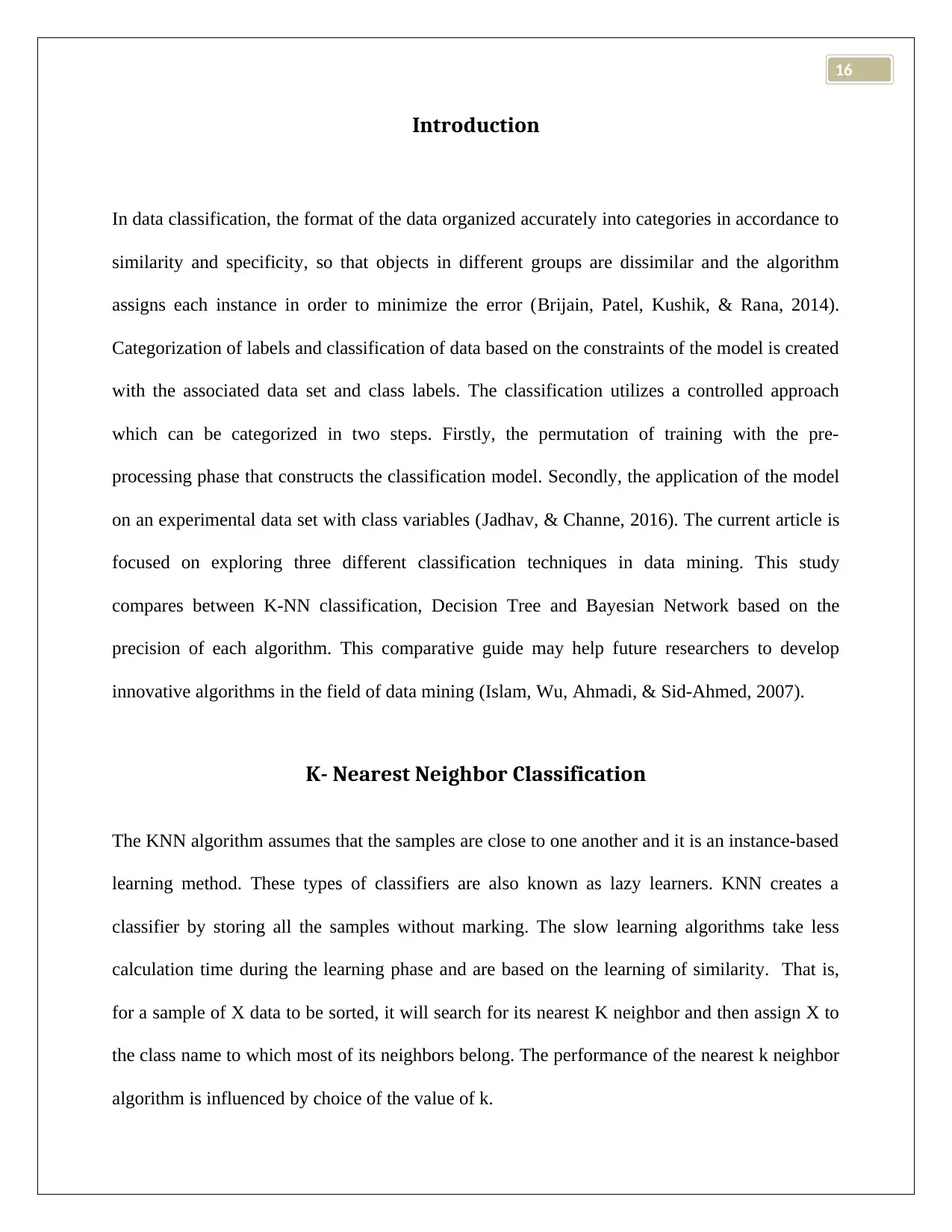
16
Introduction
In data classification, the format of the data organized accurately into categories in accordance to
similarity and specificity, so that objects in different groups are dissimilar and the algorithm
assigns each instance in order to minimize the error (Brijain, Patel, Kushik, & Rana, 2014).
Categorization of labels and classification of data based on the constraints of the model is created
with the associated data set and class labels. The classification utilizes a controlled approach
which can be categorized in two steps. Firstly, the permutation of training with the pre-
processing phase that constructs the classification model. Secondly, the application of the model
on an experimental data set with class variables (Jadhav, & Channe, 2016). The current article is
focused on exploring three different classification techniques in data mining. This study
compares between K-NN classification, Decision Tree and Bayesian Network based on the
precision of each algorithm. This comparative guide may help future researchers to develop
innovative algorithms in the field of data mining (Islam, Wu, Ahmadi, & Sid-Ahmed, 2007).
K- Nearest Neighbor Classification
The KNN algorithm assumes that the samples are close to one another and it is an instance-based
learning method. These types of classifiers are also known as lazy learners. KNN creates a
classifier by storing all the samples without marking. The slow learning algorithms take less
calculation time during the learning phase and are based on the learning of similarity. That is,
for a sample of X data to be sorted, it will search for its nearest K neighbor and then assign X to
the class name to which most of its neighbors belong. The performance of the nearest k neighbor
algorithm is influenced by choice of the value of k.
Introduction
In data classification, the format of the data organized accurately into categories in accordance to
similarity and specificity, so that objects in different groups are dissimilar and the algorithm
assigns each instance in order to minimize the error (Brijain, Patel, Kushik, & Rana, 2014).
Categorization of labels and classification of data based on the constraints of the model is created
with the associated data set and class labels. The classification utilizes a controlled approach
which can be categorized in two steps. Firstly, the permutation of training with the pre-
processing phase that constructs the classification model. Secondly, the application of the model
on an experimental data set with class variables (Jadhav, & Channe, 2016). The current article is
focused on exploring three different classification techniques in data mining. This study
compares between K-NN classification, Decision Tree and Bayesian Network based on the
precision of each algorithm. This comparative guide may help future researchers to develop
innovative algorithms in the field of data mining (Islam, Wu, Ahmadi, & Sid-Ahmed, 2007).
K- Nearest Neighbor Classification
The KNN algorithm assumes that the samples are close to one another and it is an instance-based
learning method. These types of classifiers are also known as lazy learners. KNN creates a
classifier by storing all the samples without marking. The slow learning algorithms take less
calculation time during the learning phase and are based on the learning of similarity. That is,
for a sample of X data to be sorted, it will search for its nearest K neighbor and then assign X to
the class name to which most of its neighbors belong. The performance of the nearest k neighbor
algorithm is influenced by choice of the value of k.
Paraphrase This Document
Need a fresh take? Get an instant paraphrase of this document with our AI Paraphraser
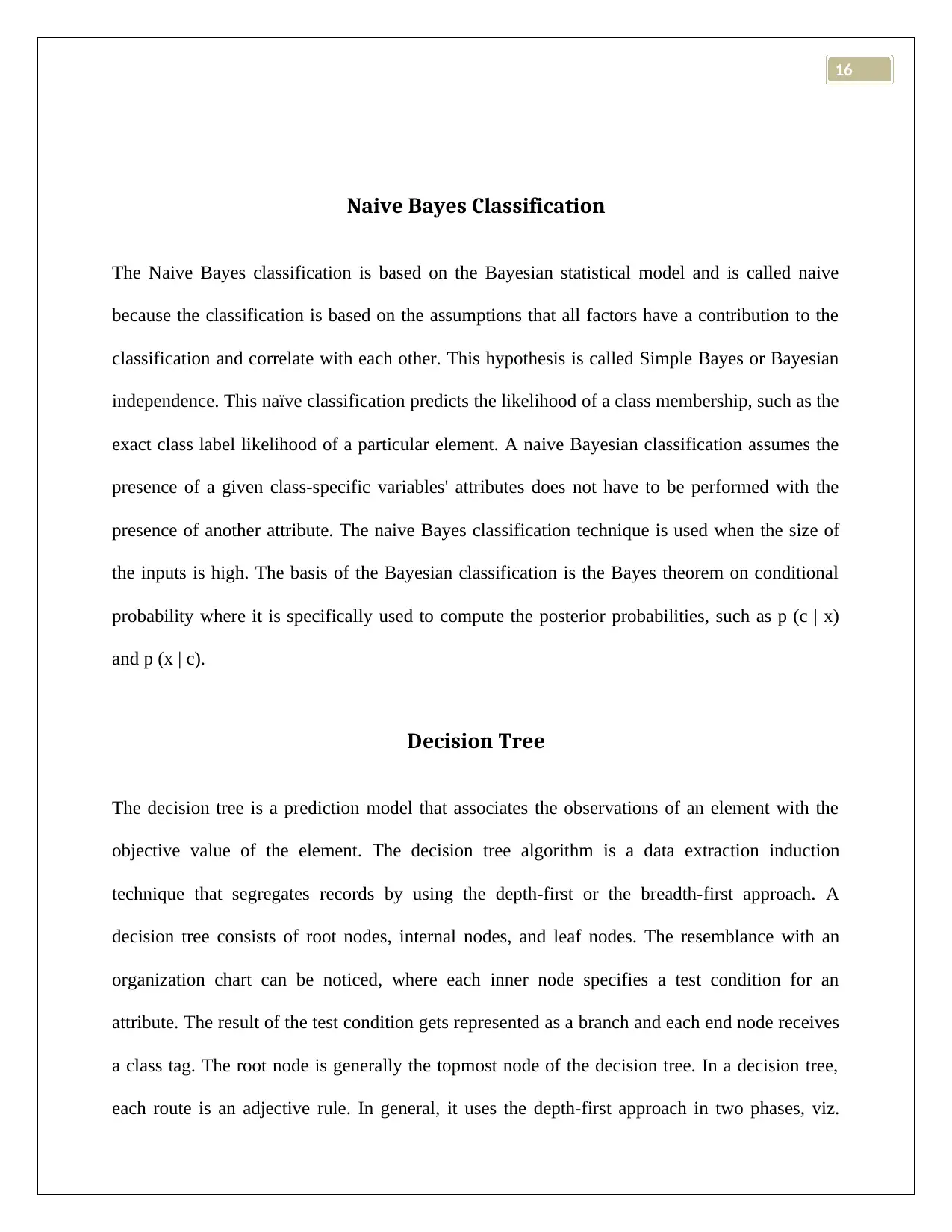
16
Naive Bayes Classification
The Naive Bayes classification is based on the Bayesian statistical model and is called naive
because the classification is based on the assumptions that all factors have a contribution to the
classification and correlate with each other. This hypothesis is called Simple Bayes or Bayesian
independence. This naïve classification predicts the likelihood of a class membership, such as the
exact class label likelihood of a particular element. A naive Bayesian classification assumes the
presence of a given class-specific variables' attributes does not have to be performed with the
presence of another attribute. The naive Bayes classification technique is used when the size of
the inputs is high. The basis of the Bayesian classification is the Bayes theorem on conditional
probability where it is specifically used to compute the posterior probabilities, such as p (c | x)
and p (x | c).
Decision Tree
The decision tree is a prediction model that associates the observations of an element with the
objective value of the element. The decision tree algorithm is a data extraction induction
technique that segregates records by using the depth-first or the breadth-first approach. A
decision tree consists of root nodes, internal nodes, and leaf nodes. The resemblance with an
organization chart can be noticed, where each inner node specifies a test condition for an
attribute. The result of the test condition gets represented as a branch and each end node receives
a class tag. The root node is generally the topmost node of the decision tree. In a decision tree,
each route is an adjective rule. In general, it uses the depth-first approach in two phases, viz.
Naive Bayes Classification
The Naive Bayes classification is based on the Bayesian statistical model and is called naive
because the classification is based on the assumptions that all factors have a contribution to the
classification and correlate with each other. This hypothesis is called Simple Bayes or Bayesian
independence. This naïve classification predicts the likelihood of a class membership, such as the
exact class label likelihood of a particular element. A naive Bayesian classification assumes the
presence of a given class-specific variables' attributes does not have to be performed with the
presence of another attribute. The naive Bayes classification technique is used when the size of
the inputs is high. The basis of the Bayesian classification is the Bayes theorem on conditional
probability where it is specifically used to compute the posterior probabilities, such as p (c | x)
and p (x | c).
Decision Tree
The decision tree is a prediction model that associates the observations of an element with the
objective value of the element. The decision tree algorithm is a data extraction induction
technique that segregates records by using the depth-first or the breadth-first approach. A
decision tree consists of root nodes, internal nodes, and leaf nodes. The resemblance with an
organization chart can be noticed, where each inner node specifies a test condition for an
attribute. The result of the test condition gets represented as a branch and each end node receives
a class tag. The root node is generally the topmost node of the decision tree. In a decision tree,
each route is an adjective rule. In general, it uses the depth-first approach in two phases, viz.
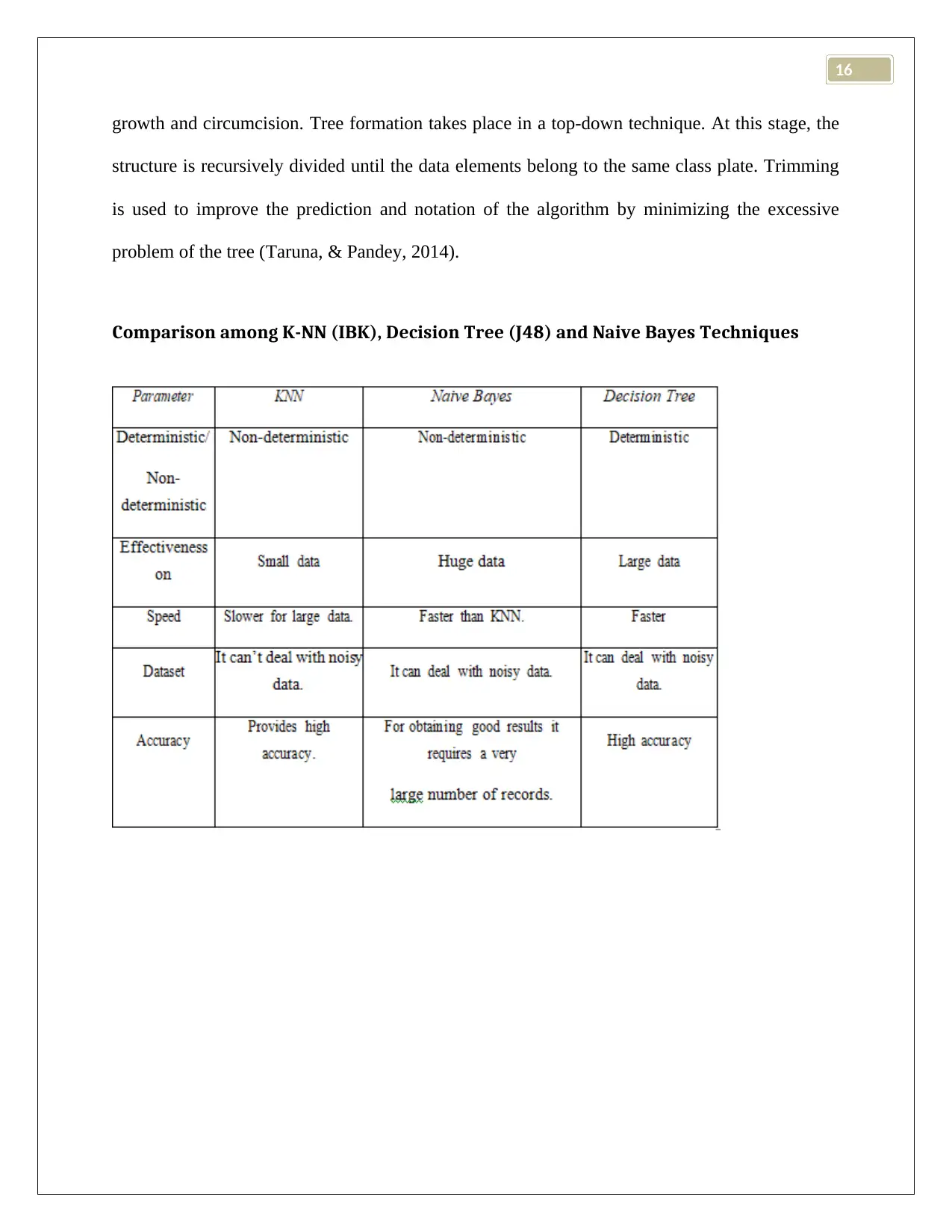
16
growth and circumcision. Tree formation takes place in a top-down technique. At this stage, the
structure is recursively divided until the data elements belong to the same class plate. Trimming
is used to improve the prediction and notation of the algorithm by minimizing the excessive
problem of the tree (Taruna, & Pandey, 2014).
Comparison among K-NN (IBK), Decision Tree (J48) and Naive Bayes Techniques
growth and circumcision. Tree formation takes place in a top-down technique. At this stage, the
structure is recursively divided until the data elements belong to the same class plate. Trimming
is used to improve the prediction and notation of the algorithm by minimizing the excessive
problem of the tree (Taruna, & Pandey, 2014).
Comparison among K-NN (IBK), Decision Tree (J48) and Naive Bayes Techniques
⊘ This is a preview!⊘
Do you want full access?
Subscribe today to unlock all pages.

Trusted by 1+ million students worldwide
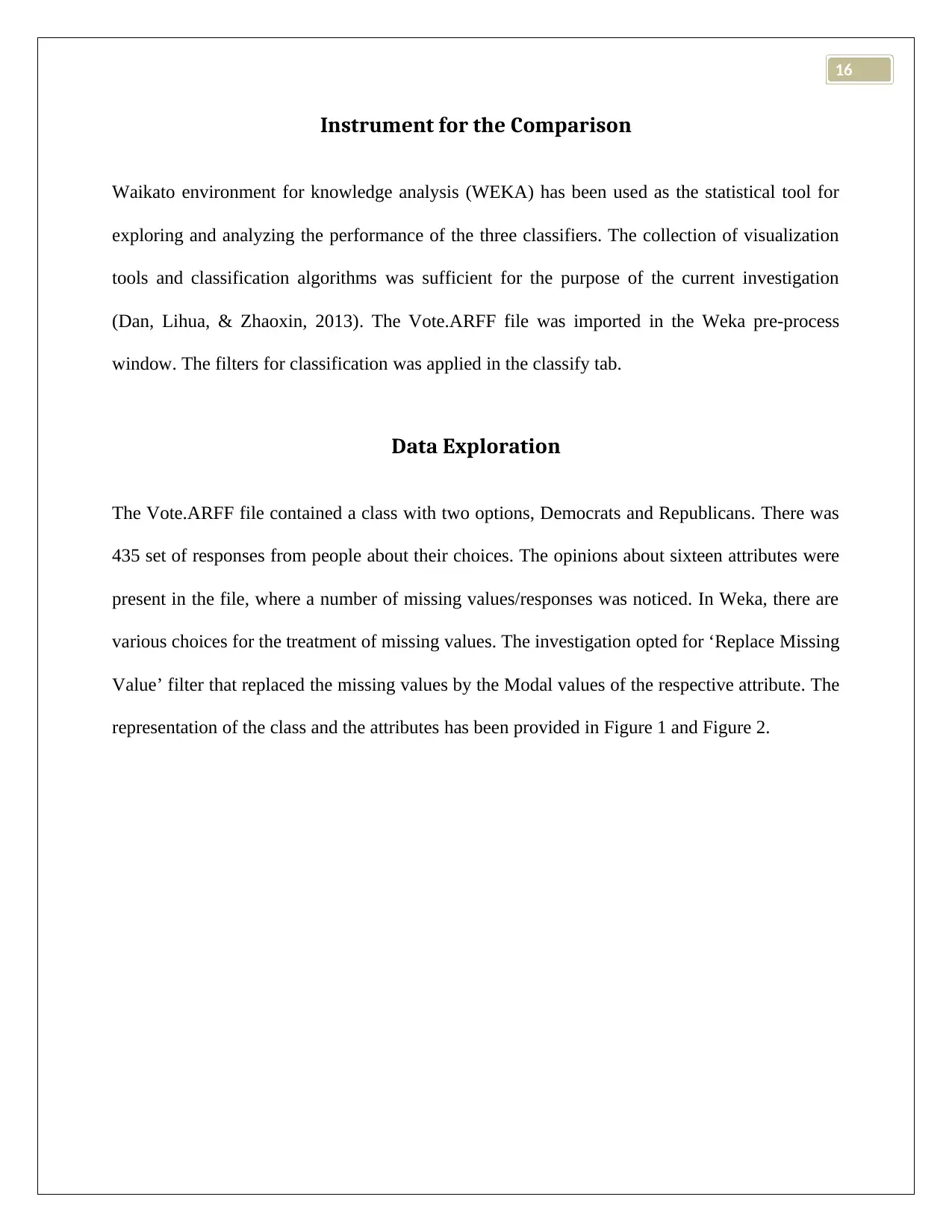
16
Instrument for the Comparison
Waikato environment for knowledge analysis (WEKA) has been used as the statistical tool for
exploring and analyzing the performance of the three classifiers. The collection of visualization
tools and classification algorithms was sufficient for the purpose of the current investigation
(Dan, Lihua, & Zhaoxin, 2013). The Vote.ARFF file was imported in the Weka pre-process
window. The filters for classification was applied in the classify tab.
Data Exploration
The Vote.ARFF file contained a class with two options, Democrats and Republicans. There was
435 set of responses from people about their choices. The opinions about sixteen attributes were
present in the file, where a number of missing values/responses was noticed. In Weka, there are
various choices for the treatment of missing values. The investigation opted for ‘Replace Missing
Value’ filter that replaced the missing values by the Modal values of the respective attribute. The
representation of the class and the attributes has been provided in Figure 1 and Figure 2.
Instrument for the Comparison
Waikato environment for knowledge analysis (WEKA) has been used as the statistical tool for
exploring and analyzing the performance of the three classifiers. The collection of visualization
tools and classification algorithms was sufficient for the purpose of the current investigation
(Dan, Lihua, & Zhaoxin, 2013). The Vote.ARFF file was imported in the Weka pre-process
window. The filters for classification was applied in the classify tab.
Data Exploration
The Vote.ARFF file contained a class with two options, Democrats and Republicans. There was
435 set of responses from people about their choices. The opinions about sixteen attributes were
present in the file, where a number of missing values/responses was noticed. In Weka, there are
various choices for the treatment of missing values. The investigation opted for ‘Replace Missing
Value’ filter that replaced the missing values by the Modal values of the respective attribute. The
representation of the class and the attributes has been provided in Figure 1 and Figure 2.
Paraphrase This Document
Need a fresh take? Get an instant paraphrase of this document with our AI Paraphraser
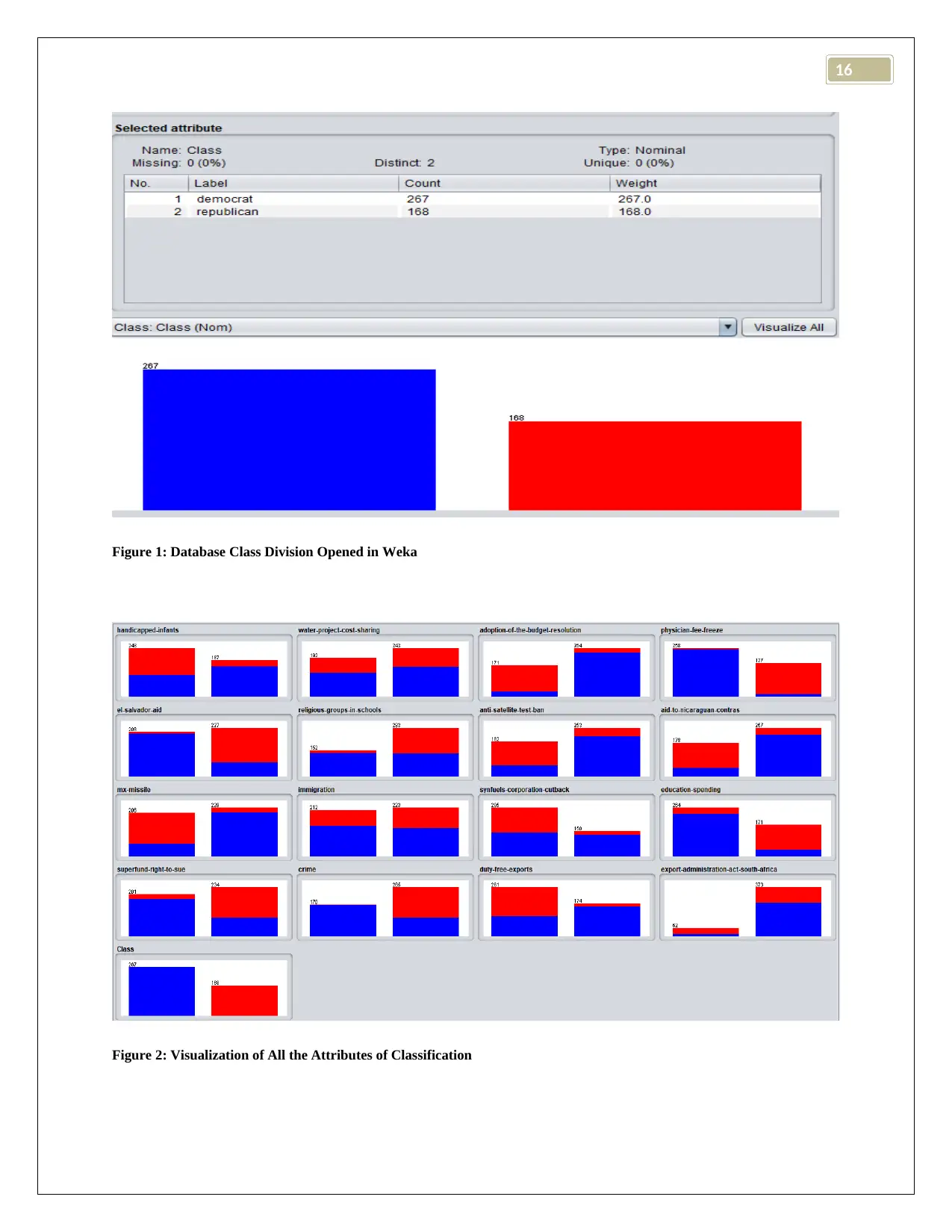
16
Figure 1: Database Class Division Opened in Weka
Figure 2: Visualization of All the Attributes of Classification
Figure 1: Database Class Division Opened in Weka
Figure 2: Visualization of All the Attributes of Classification
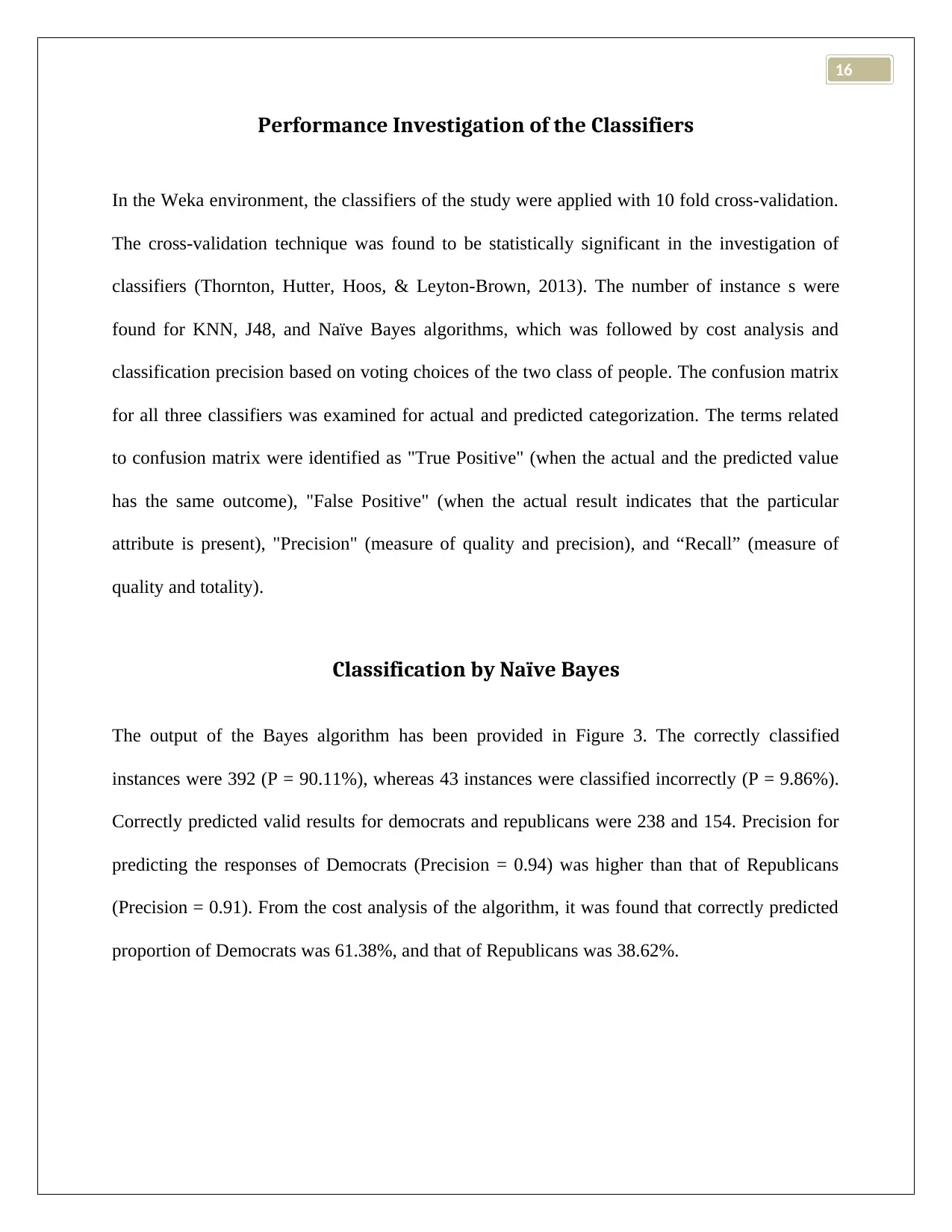
16
Performance Investigation of the Classifiers
In the Weka environment, the classifiers of the study were applied with 10 fold cross-validation.
The cross-validation technique was found to be statistically significant in the investigation of
classifiers (Thornton, Hutter, Hoos, & Leyton-Brown, 2013). The number of instance s were
found for KNN, J48, and Naïve Bayes algorithms, which was followed by cost analysis and
classification precision based on voting choices of the two class of people. The confusion matrix
for all three classifiers was examined for actual and predicted categorization. The terms related
to confusion matrix were identified as "True Positive" (when the actual and the predicted value
has the same outcome), "False Positive" (when the actual result indicates that the particular
attribute is present), "Precision" (measure of quality and precision), and “Recall” (measure of
quality and totality).
Classification by Naïve Bayes
The output of the Bayes algorithm has been provided in Figure 3. The correctly classified
instances were 392 (P = 90.11%), whereas 43 instances were classified incorrectly (P = 9.86%).
Correctly predicted valid results for democrats and republicans were 238 and 154. Precision for
predicting the responses of Democrats (Precision = 0.94) was higher than that of Republicans
(Precision = 0.91). From the cost analysis of the algorithm, it was found that correctly predicted
proportion of Democrats was 61.38%, and that of Republicans was 38.62%.
Performance Investigation of the Classifiers
In the Weka environment, the classifiers of the study were applied with 10 fold cross-validation.
The cross-validation technique was found to be statistically significant in the investigation of
classifiers (Thornton, Hutter, Hoos, & Leyton-Brown, 2013). The number of instance s were
found for KNN, J48, and Naïve Bayes algorithms, which was followed by cost analysis and
classification precision based on voting choices of the two class of people. The confusion matrix
for all three classifiers was examined for actual and predicted categorization. The terms related
to confusion matrix were identified as "True Positive" (when the actual and the predicted value
has the same outcome), "False Positive" (when the actual result indicates that the particular
attribute is present), "Precision" (measure of quality and precision), and “Recall” (measure of
quality and totality).
Classification by Naïve Bayes
The output of the Bayes algorithm has been provided in Figure 3. The correctly classified
instances were 392 (P = 90.11%), whereas 43 instances were classified incorrectly (P = 9.86%).
Correctly predicted valid results for democrats and republicans were 238 and 154. Precision for
predicting the responses of Democrats (Precision = 0.94) was higher than that of Republicans
(Precision = 0.91). From the cost analysis of the algorithm, it was found that correctly predicted
proportion of Democrats was 61.38%, and that of Republicans was 38.62%.
⊘ This is a preview!⊘
Do you want full access?
Subscribe today to unlock all pages.

Trusted by 1+ million students worldwide
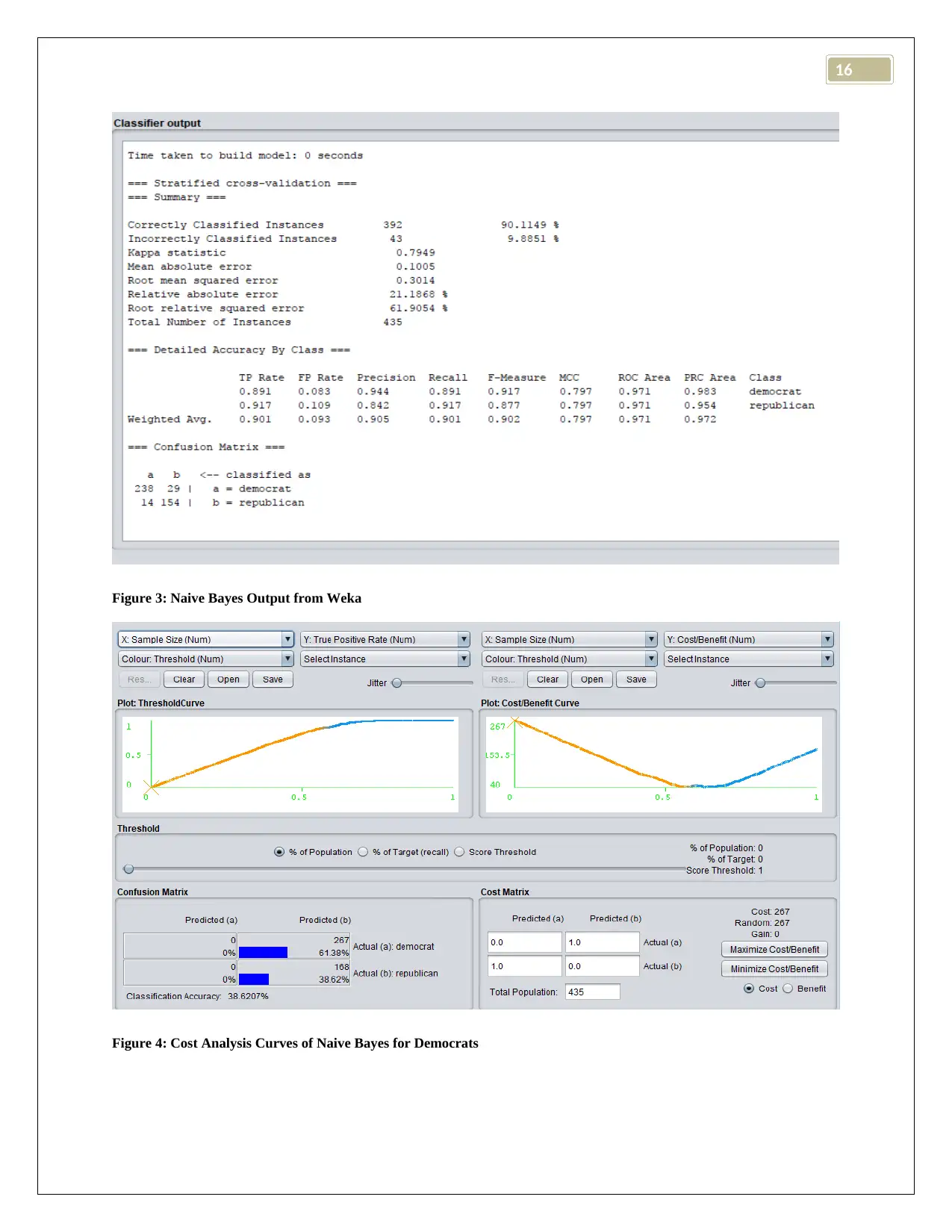
16
Figure 3: Naive Bayes Output from Weka
Figure 4: Cost Analysis Curves of Naive Bayes for Democrats
Figure 3: Naive Bayes Output from Weka
Figure 4: Cost Analysis Curves of Naive Bayes for Democrats
Paraphrase This Document
Need a fresh take? Get an instant paraphrase of this document with our AI Paraphraser
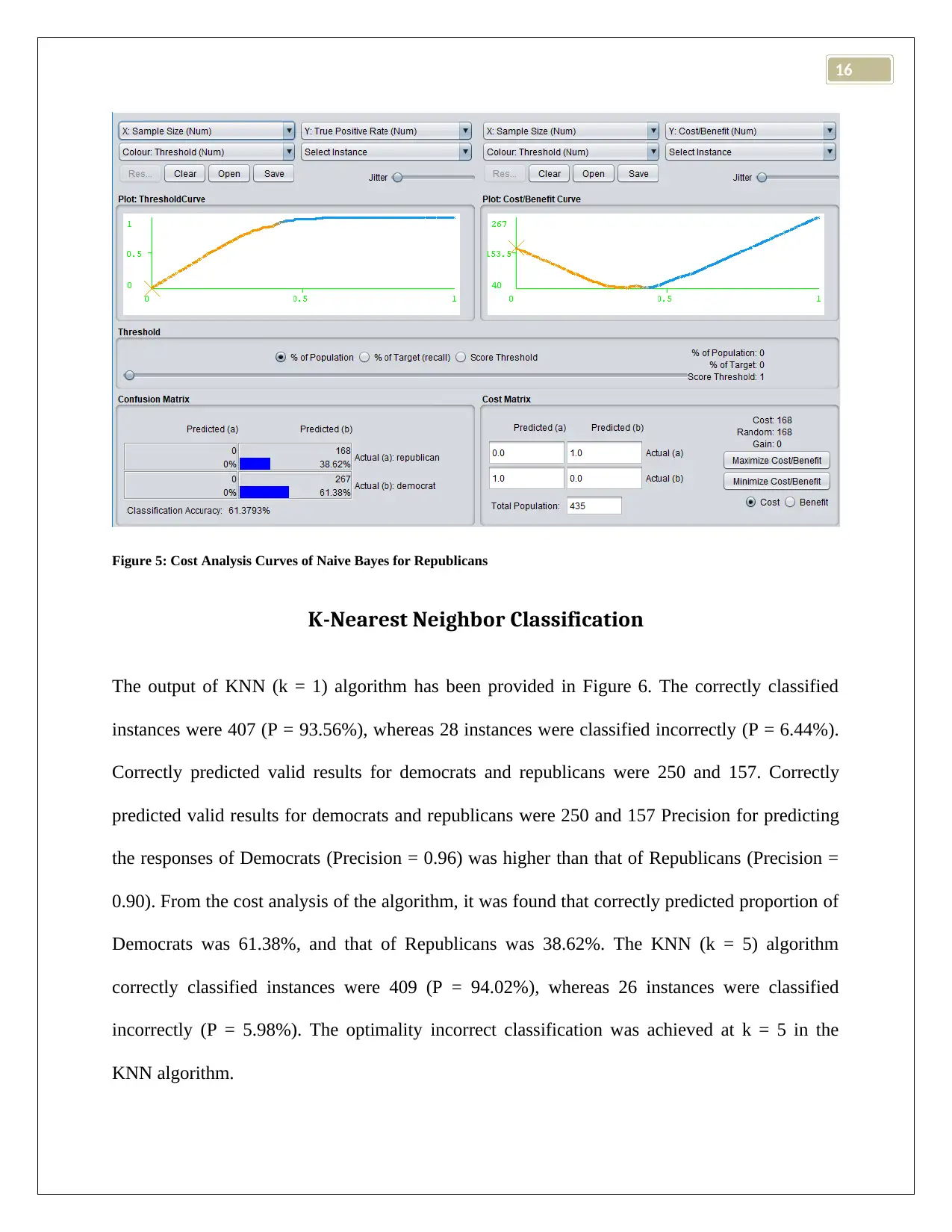
16
Figure 5: Cost Analysis Curves of Naive Bayes for Republicans
K-Nearest Neighbor Classification
The output of KNN (k = 1) algorithm has been provided in Figure 6. The correctly classified
instances were 407 (P = 93.56%), whereas 28 instances were classified incorrectly (P = 6.44%).
Correctly predicted valid results for democrats and republicans were 250 and 157. Correctly
predicted valid results for democrats and republicans were 250 and 157 Precision for predicting
the responses of Democrats (Precision = 0.96) was higher than that of Republicans (Precision =
0.90). From the cost analysis of the algorithm, it was found that correctly predicted proportion of
Democrats was 61.38%, and that of Republicans was 38.62%. The KNN (k = 5) algorithm
correctly classified instances were 409 (P = 94.02%), whereas 26 instances were classified
incorrectly (P = 5.98%). The optimality incorrect classification was achieved at k = 5 in the
KNN algorithm.
Figure 5: Cost Analysis Curves of Naive Bayes for Republicans
K-Nearest Neighbor Classification
The output of KNN (k = 1) algorithm has been provided in Figure 6. The correctly classified
instances were 407 (P = 93.56%), whereas 28 instances were classified incorrectly (P = 6.44%).
Correctly predicted valid results for democrats and republicans were 250 and 157. Correctly
predicted valid results for democrats and republicans were 250 and 157 Precision for predicting
the responses of Democrats (Precision = 0.96) was higher than that of Republicans (Precision =
0.90). From the cost analysis of the algorithm, it was found that correctly predicted proportion of
Democrats was 61.38%, and that of Republicans was 38.62%. The KNN (k = 5) algorithm
correctly classified instances were 409 (P = 94.02%), whereas 26 instances were classified
incorrectly (P = 5.98%). The optimality incorrect classification was achieved at k = 5 in the
KNN algorithm.
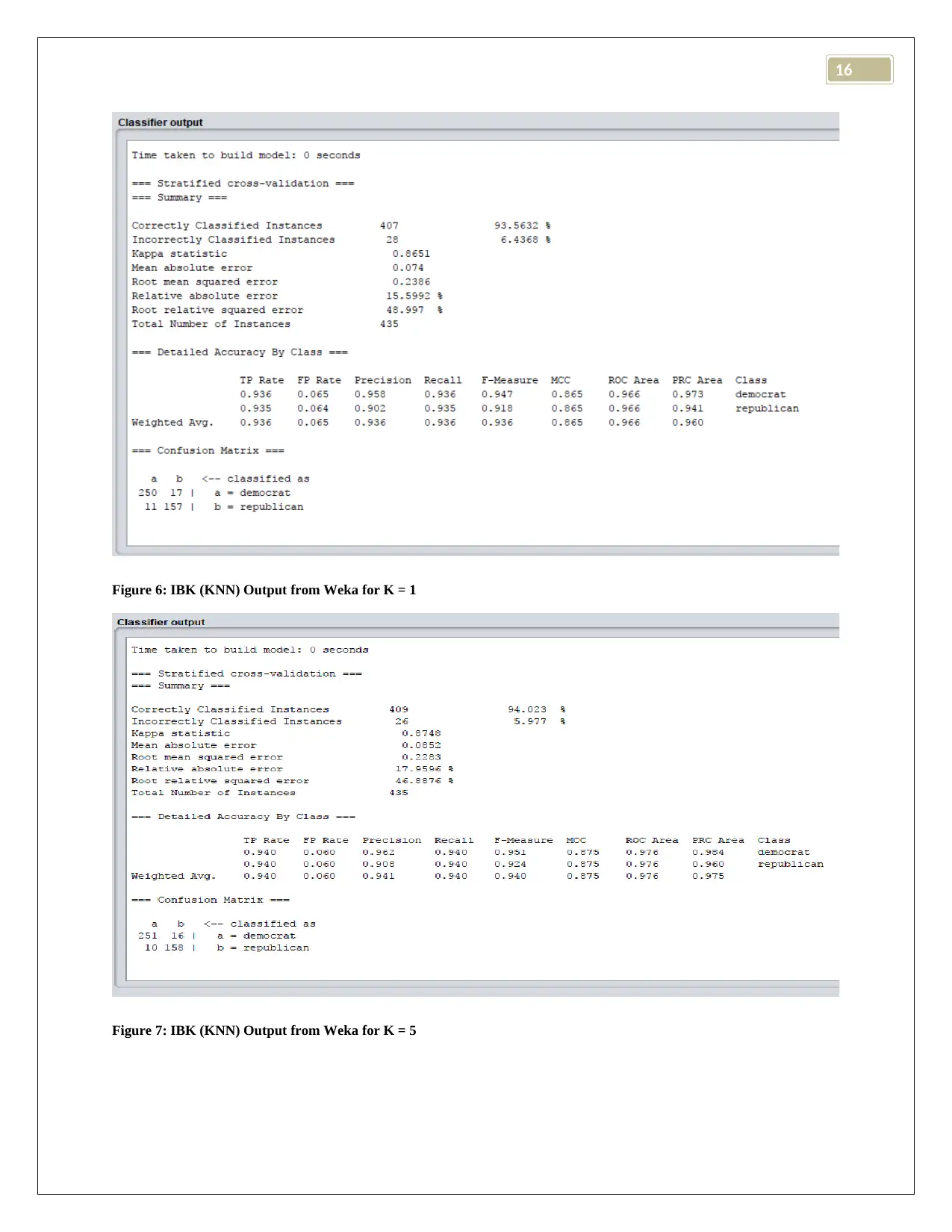
16
Figure 6: IBK (KNN) Output from Weka for K = 1
Figure 7: IBK (KNN) Output from Weka for K = 5
Figure 6: IBK (KNN) Output from Weka for K = 1
Figure 7: IBK (KNN) Output from Weka for K = 5
⊘ This is a preview!⊘
Do you want full access?
Subscribe today to unlock all pages.

Trusted by 1+ million students worldwide
1 out of 19
Related Documents
Your All-in-One AI-Powered Toolkit for Academic Success.
+13062052269
info@desklib.com
Available 24*7 on WhatsApp / Email
![[object Object]](/_next/static/media/star-bottom.7253800d.svg)
Unlock your academic potential
Copyright © 2020–2025 A2Z Services. All Rights Reserved. Developed and managed by ZUCOL.




